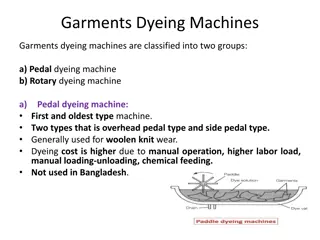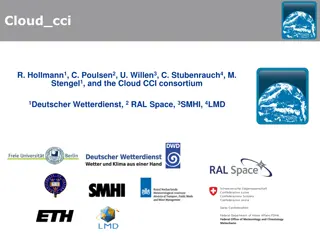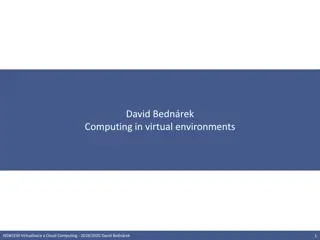Implementing Version Control for Virtual Machines in Open-Source Cloud
This article discusses the implementation of version control for virtual machines in open-source cloud environments, addressing challenges such as scalability, network bandwidth, and hardware configurations. The CloudVS system is introduced as an add-on for managing VM versions in low-cost commodity settings.
Download Presentation

Please find below an Image/Link to download the presentation.
The content on the website is provided AS IS for your information and personal use only. It may not be sold, licensed, or shared on other websites without obtaining consent from the author.If you encounter any issues during the download, it is possible that the publisher has removed the file from their server.
You are allowed to download the files provided on this website for personal or commercial use, subject to the condition that they are used lawfully. All files are the property of their respective owners.
The content on the website is provided AS IS for your information and personal use only. It may not be sold, licensed, or shared on other websites without obtaining consent from the author.
E N D
Presentation Transcript
CloudVS: Enabling Version Control for Virtual Machines in an Open- Source Cloud under Commodity Settings Chung-Pan Tang, Tsz-Yeung Wong, Patrick P. C. Lee The Chinese University of Hong Kong NOMS 12 1
Using Cloud Computing Cloud computing is real But many companies still hesitate to use public clouds e.g., security concerns Open-source cloud platforms Self-manageable with cloud-centric features Extensible with new functionalities Deployable with low-cost commodity hardware Examples: Eucalyptus, OpenStack 2
Private Cloud Deployment In most private cloud systems, virtual machines (VMs) are created on demand, and disposed when finished i.e., work without persistent storage Create Terminate VM VM VM image storage 3
Reliability of VMs The disposable assumption may not be adequate: Accidental VM crashes Temporary VM termination for resource rearrangement Question: How to ensure the reliability of VMs toward failures with low-cost commodity hardware? One option: version control 4
What is Version Control? User s point of view 0 A.1 B.1 A.2 A.1 B.1 Idea. Manage changes to files, documents. A.2 5
Challenges Design challenges of enabling version control for VMs in an open-source cloud platform: Can it scale to many VM versions? e.g., maintain a large volume of VM versions within a cloud Can it work with limited network bandwidth? e.g., huge transmission overhead of VM images Can it work with low-cost commodity configurations? e.g., a few GB of RAM, 32/64-bit CPU, standard OS 6
Related Work VM management: VM checkpointing e.g., [Nicolae, HPDC'11] VM migration e.g., CloudNet [Wood, VEE '10] VM image storage e.g., Mirage [Reimer, VEE '08], LiveDFS [Ng, Middleware 11] Limited studies on open-source cloud systems 7
Our Work CloudVS: an add-on system of VM version control in an open-source cloud Design goals of CloudVS: Target open-source clouds deployed on low-cost commodity hardware and OS Provide version control operations, while minimizing the overhead during versioning and restore processes 8
Our Work Design features of CloudVS: Versioning with redundancy elimination: only process the changed part of each VM snapshot version Tunable delta storage: trade between the restore performance and storage overhead I/O Optimization: minimize interferences to co- resident VM instances during versioning 9
Our Work VM Image Storage Deploy CloudVS on Eucalyptus testbed CloudVS serves as a storage layer between compute nodes and VM image storage CloudVS Evaluate versioning operations and compare with full image approach Pool of Compute Nodes 10
Basics: Snapshot A VM snapshot is a read-only copy of the disk, at a particular point of time To preserve states of VM, Snapshots are taken regularly and sent to persistent storage Inefficient to store and transfer the raw snapshots Solution: use redundancy elimination to exploit content similarity 11
Basics: Fingerprints How to compare VM snapshots? Solution: Divide a VM snapshot into chunks and use cryptographic hashes (or fingerprints) Hash-based comparisons Same content same hash Different content different hashes with high probability 4K Bytes New block Pros: block comparison reduced to hash comparison MD5 or SHA-1 Cons: collision may occur, but with negligible probability [Quinlan & Dorward, 02] MD5 SHA-1 16 Bytes 20 Bytes 12
Basics: Delta 17 18 Merge Base file Target file Delta file A delta is an object that specifies the content differences between a base file and a target file A + Delta(A,B) = B 13
Basics: Deltas in Versions Two common approaches to version series: Incremental deltas Delta(version 1, version 2), Delta(version 2, version 3), Delta(version i-1, version i) Differential deltas Delta(version 1, version 2), Delta(version 1, version 3), Delta(version 1, version i) There is storage overhead to store version series by differential delta 14
Incremental Deltas? Storage with incremental deltas To restore n-th version, We need to all deltas from 1 to n i.e. Delta(1,2) ; Delta(2,3) ; Delta(3,4) ; and merge delta one-by-one Problem: Incurs lots of disk seeks due to fragmentation 1st 2nd 3rd 15
Tunable Delta Storage Our heuristic design uses a single parameter trade between fragmentation and storage overhead explore intermediates between extremes of storing incremental and differential deltas Main idea: extract non-sequential parts and store them sequentially The top proportion (in term of no. of seeks) will be stored as differential deltas = 1 only differential delta is stored = 0 only incremental delta is stored 16
Tunable Example Version 1 Version 2 Metadata 1 2 3 4 5 6 7 1 2 3 4 5 6 7 Data chunks 1 2 3 4 5 6 7 3 5 6 7 5 To restore versions, we need chunks: For version 1: {3 , 5 }, {6 , 7 } For version 2: {3 , 5 } (most seeks!), {6 , 7 } 17
Tunable Example Version 1 Version 2 Metadata 1 2 3 4 5 6 7 1 2 3 4 5 6 7 Data chunks 1 2 3 4 5 6 7 3 5 6 7 3 5 For = 0.5, chunk size = 2 Trade storage for the restore performance 18
CloudVS Design Base VM images Tunable Delta Storage Differential deltas Incremental deltas VM Image Storage Compute Nodes Taking snapshot by LVM Redundancy elimination: fixed-size chunking Several I/O Optimizations pre-declaring access patterns, rate limiting of disk reads Details in the paper 19
Experiments Eucalyptus deployment 4 compute node 1 storage node Gigabit switch connection VM Image Storage Datasets 90 daily-snapshot VM images of Fedora 14 Each VM image is of size 5GB CloudVS VM operations via euca2tools: Launch VM instances Terminate VM instances 20
Restore Performance Full image download: 162s CloudVS saves 25-51% time over whole image restore 21
Versioning Performance Versioning takes 80-100 seconds, which costs only < 5 seconds for VM freezing 22
Multiple Restore Performance CloudVS use 50% less startup time then that of full base images, for example, when N= 32 23
Effect of Tunable Storage The smaller leads to more restore time Eg. = 0.5, the restore time is 3 seconds more than the = 1 (purely differential deltas) 24
Storage Usage But the smaller leads to less storage space. e.g., = 0.5, the storage consumes 35% less storage than the = 1 (purely differential deltas)25
Summary of Results CloudVS saves both bandwidth and storage by redundancy elimination CloudVS trades between the restore performance and storage overhead Microbenchmark experiments to study impact of each design features See details in paper 26
Conclusions Deploy VM version control in an open-source cloud platform with commodity settings Propose CloudVS, an add-on system Versioning with redundancy elimination Tunable delta storage trading between the fragmentation and storage overhead Several I/O optimizations to improve performance on commodity setting Source code: http://ansrlab.cse.cuhk.edu.hk/software/cloudvs 27























